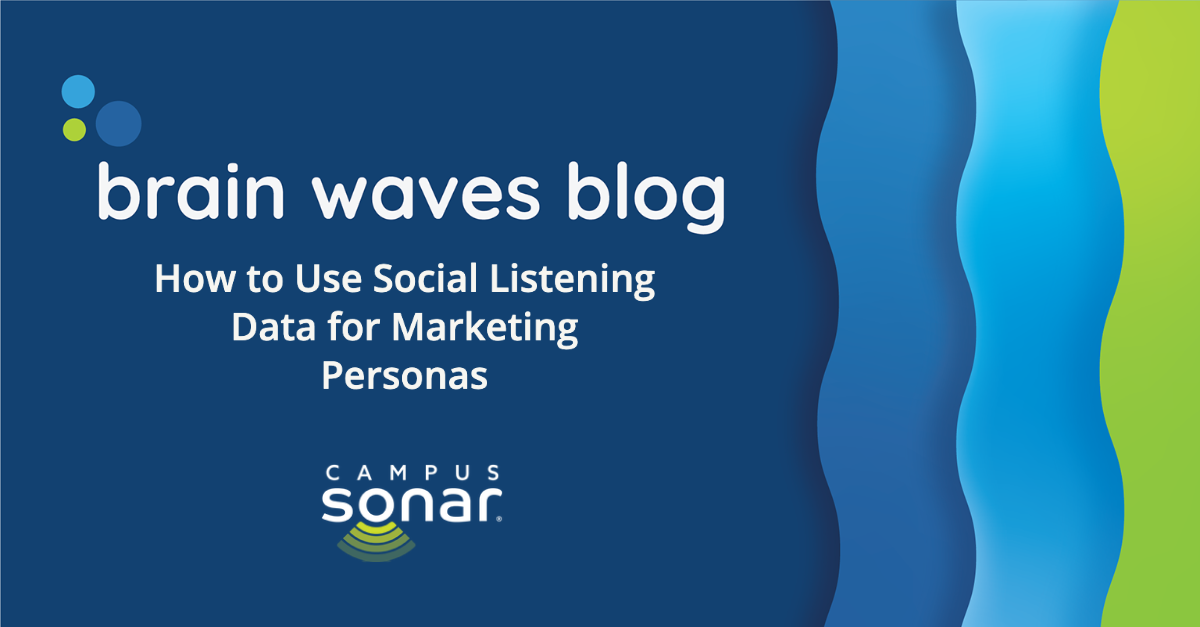How to Use Social Listening Data for Marketing Personas

Hearing the word “research” may elicit a groan from people—some perceive it as over-thinking a topic or too time consuming. However, the right type and amount of research allows individuals and organizations to make decisions that can save money (by preventing investment in dead-end solutions) or increase revenue (by allocating resources to make the most impact). Campus Sonar clients have seen how prospective student research, through social listening, can inform campus outreach with data-informed marketing and communications personas. In fact, crafting personas based on real-life data can result in content that’s customized for prospective students—which can positively increase yield rate as prospective students receive resonating messages on channels they prefer.
Types of Data for a Prospective Student Persona
For campuses developing content strategy, creating a marketing and communications persona helps bring the profile of your prospective student to life and incorporates a number of data points. Make sure you build your persona with a variety of inputs from three types of data.
- Academic. Define the typical academic makeup of your target students.
- Demographic. What are the demographic details of these students? Where are they located?
- Psychographic. Typical details such as the attitudes, values, and preferences of your target audience can help you reach them with messages that resonate with their attitude and beliefs.
Your institution typically determines academic information, depending on the type of students you want to seat for the next class, and demographic information is available from several online resources (such as the American FactFinder)—but psychographic information can be more challenging to find. Institutions can leverage sources of secondary research, such as what others collect about your target audience, as well as primary research—asking your target audience their beliefs and preferences.
Traditional methods of primary research include focus groups, surveys, and interviews with your target audience. However, as we’ve argued in previous posts, rather than tell a researcher—let alone a higher education professional—students are more likely to tell the internet what they feel, think, and believe. Social listening used to gather psychographic details about students can complement traditional research methods—it's an online focus group.
Identify Prospective Students Online
If you’re using social listening to analyze a target audience like prospective students, the first step is to identify online accounts of high school students who fit your academic and demographic profiles. Here are a few ways to do so.
- Search forums like Reddit (e.g., the Applying for College subreddit) or College Confidential.
- Collect social media handles from prospective student tours or events.
- Leverage social media platform search functionality to search for students who talk about applying to your school—or Tweetdeck to quickly search Twitter.
- Use a social listening tool to write a query to identify prospective students.
Analyze Conversations for Psychographics
Once you have a sample of prospective students identified through their online accounts, you can analyze their conversations for trends and answer specific psychographic questions. For example:
- Topics they tend to talk about. Kim Kardashian or Kristen Bell?
- What they believe in. Equality or fairness?
- Personality traits. Goal-oriented or fun-seeking?
Your sample of prospective students likely won’t illustrate extremes such as the examples above, but by identifying trends, you’ll be able to use your findings to build your prospective student persona—and inform the communication strategies and messages you create to reach this audience.
Leveraging Your Persona
Depending on your recruitment goals and the prospective student profile research results, the persona for this audience can—and should—vary between higher education institutions. No matter—using unique data touchpoints from your prospective student persona in your prospective student communications can result in those messages being more impactful with that audience.
For example, if you find that your target prospective students are goal oriented and influenced by female politicians, as evidenced from their online conversations, you may want to send a communication from the leader of the student government on campus—who happens to identify as female and chose to attend your school because it matched her career goals.
Rather than being a shot in the dark, communications to prospective students that are built on data-informed personas have the potential to be more impactful and positively affect annual recruitment goals because your messaging is customized to your audience. In this case, the word “research” shouldn’t cause you to shrug in fear—while you may not be jumping up and down for joy, social listening research is definitely cause for excitement, since (compared to traditional research methods) it’s a quick and flexible way to better understand prospective students.

